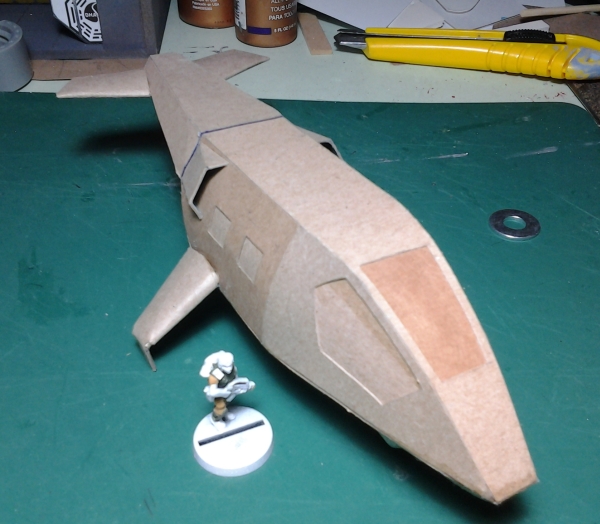I didn't take as many pics as I thought I did so less of a tutorial than I thought it would be.
The basic framework is made from illustration board which is quite rigid and makes a great substructure. Basically it is a bunch of cross sections of how I want the final shape to be. I added foamboard cutoffs cut to shape to provide a greater gluing surface; generally not much edge is needed for gluing but this helps.

Here you can see the dowel used to support the tail section.

***Important to note that cardboard has a direction of natural curvature so when cutting out pieces one should take that into consideration; that makes for smoother curves and the cardboard is less likely to crack. Also curving the cardboard in several small increments helps too instead of in one go.***
Below you can see the first panels being added. Generally I place a slightly larger piece of cardboard against the structure where it will finally be, trace it with a pen, and gradually trim it to fit. This sometimes needs a third hand or some low tack painters tape. This becomes my template piece which I use to cut out the panels.
The door is just pen heavily drawn in to create the panel lines.
How on earth did you get the cereal card to conform to those curves and stay there while the adhesive dried? Great work!
I glue the pieces using Aleenes Tacky glue and just hold it in place with my fingers for a few minutes; it sets up fairly quickly. I usually have some show or film playing in the background so just watch that. Sometimes I use elastics or clothes pins. I also added some extra tabs to give a greater gluing area but just edge to edge is what I usually use. Also you can see on the left most panel I added a second layer of cardboard to give greater surface strength; I precurved the pieces before gluing them together.

I then add a second layer of cardboard, with cutout features to create the recessed areas, windows, etc. I use the templates I created earlier and cut out pieces that are slightly larger so it will fit over the larger area created by the first layer. A lot of gentle trimming and dry-fitting until it fits just right then glued in place. The second layer greatly increases the strength of the model.

A couple of washers are retrofitted as weight added to the front to keep it from tipping too easily. I probably won't add much detail to the bottom as it is usually not seen. I added a layer of foamboard and cut the edges at an angle so could have a solid surface to glue the bottom trim on. No photos of the winglets being built. I drilled a hole through the structure to pass the coat hanger wire through and bent it carefully with some pliers. I then built up the wing surface from an initial illustration board shape and two layers of cardboard to create the wing shape.

Here is another view with the new intake vents.

Hopefully this gives some insight on how I got this far.